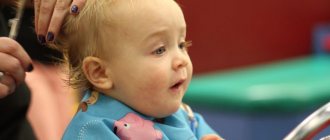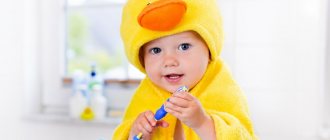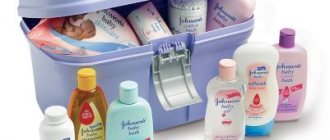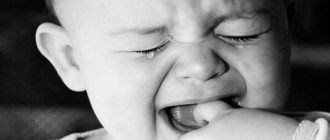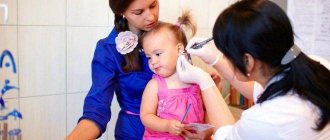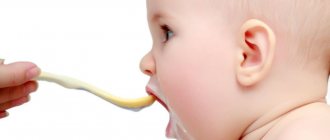Do you need to brush your teeth?
Alas, many parents still mistakenly believe that there is no need to care for baby teeth, and all care and care should be directed to the molars. However, such an opinion is fundamentally wrong. It is imperative to brush your baby's teeth.
- Firstly, the enamel of baby teeth is very weak, and caries affects fragile incisors and molars very easily.
- Secondly, mother's breast milk and formula contain a significant amount of sugar, which inevitably affects the baby's teeth.
- Thirdly, teeth affected by caries can become a source of infection in the oral cavity. Dangerous bacteria can spread throughout the body, causing serious diseases in the baby, such as tonsillitis or pyelonephritis and, of course, subsequently “infecting” the molars.
- Fourthly, it is important to form the habit of brushing your baby’s teeth from a very early age.
It is important for moms and dads to understand that visiting dentists at a young age can be very frightening for a child. Neglected caries can very quickly develop into pulpitis, and the baby’s tooth will be removed, which will inevitably affect the chewing process and the formation of the child’s bite.
Period of toothless mouth of an infant
A characteristic feature of the first half of a child’s life is the presence of a pronounced sucking reflex, to which all elements of the masticatory apparatus are adapted (see Fig. 29, 30). These include lips that are trunk-shaped and have a well-defined circular muscle; gingival membrane, which is a duplicated fold of the mucous membrane with a developed network of elastic fibers. It is located on the alveolar processes of the jaws and is well expressed in the frontal area. The gingival membrane (Fig. 31) has the shape of a regular semicircle, and with the mouth closed, the upper roller is in contact with the lower one along its entire length. This shape and relationship of the ridges are maintained until the eruption of the first teeth.
Rice. 30. Types of jaw relationships in a newborn (Clinch L.): a — front view, b — side view.
Transverse palatine folds (rugae palatinae transversae) in the number of 4-5 pairs create roughness in the anterior part of the hard palate and help retain the nipple (Fig. 32). The fatty layer of the cheeks and the Bisha lump act as a soft pad to create a better seal in the oral cavity during the act of sucking. The category of facts of adaptation of the newborn's oral cavity to food intake also includes the distal position of the lower jaw or the so-called infant retrogenia (see Fig. 21, c), the absence of an articular tubercle and the free movement of the lower jaw in the sagittal direction. As is known, in order to squeeze milk out of the nipple (nipple), a child moves the lower jaw forward and makes rhythmic movements from front to back, with the help of which the milk is squeezed out. By the end of infancy, this retrogeny, thanks to the rhythmic movements of the lower jaw during the act of sucking, turns into orthognathy. Rice. 31. Gingival membrane (according to Korkhaus) - explanation in the text.
Rice. 32. Hard and soft palate of a newborn (Kurlyandsky V.Yu.) - explanation in the text.
Rice. 33. The location of the larynx in relation to the spinal column during growth, the bolder line indicates the V cervical vertebra (Andronescu A.).
In addition, the topography of the larynx in an infant is different than in an adult. An adult is unable to breathe while swallowing, but an infant swallows and breathes at the same time. This can be explained by the fact that the larynx is short, wide and located three vertebrae higher than in an adult. It descends and reaches its final position at the age of 13 (Fig. 33). In an infant, the entrance to the larynx lies high above the infero-posterior edge of the velum palatine and is connected only to the nasal cavity. The path for food is located in the child on the sides of the larynx, where there is communication between the oral cavity and the pharynx. These anatomical relationships in the area of the root of the tongue and larynx in a child allow him to simultaneously breathe and swallow food. This feature is vitally important, since the baby does not have to interrupt sucking during breathing movements, which would be very tiring for him.
When should you start taking care of your teeth?
Most dentists agree that the start of brushing a baby's teeth should coincide with their appearance. Most often, the first tooth erupts in babies' mouths at six months. However, in some children, the first incisors appear earlier, and some delight their parents with their first tooth only at one year of age.
An erupted tooth is a tooth whose tip has already emerged from the gums. Caring for the baby's first incisors should be carried out as carefully as possible - often a real wound forms around the cutting pearl and cleaning can be very painful for the baby. In addition, we should not forget that during teething, the baby’s local immunity decreases and the risk of contracting an infection increases.
Some dentists are convinced that oral care for infants should begin before teeth appear. The fact is that even in the absence of incisors and molars, and even in the absence of complementary foods in the diet, microorganisms accumulate on the baby’s oral mucosa. These bacteria can cause unpleasant diseases such as stomatitis, gingivitis or candidiasis.
In addition, such early care of your baby’s gums will help him form a habit of hygiene. And at the age of 5-6 months, when the baby begins to distinguish between “his own and someone else’s,” a toothbrush and special pastes will no longer cause him to panic and protest. According to dentists, infants should start brushing their teeth at the age of 3-4 months.
Child’s oral hygiene – importance and necessity
According to statistics and WHO reports, more than 92% of people around the world not only do not use effective approaches to oral care themselves, but also do not teach this to their children. Only some vigilant parents take into account that the oral cavity of a child is different from that of an adult, and caring for baby teeth differs from preventing the teeth of an adult.
Our Children's Dentistry in Rostov-on-Don is one of the leading clinics where professional dentists help parents and children, in the initial stages of growing up and life, to provide proper dental care and oral cavity prevention. The main types of teeth that receive special attention are the sixth teeth and the first molars. The sixth teeth begin to erupt earlier than the others, therefore they are more vulnerable compared to other bone tissues. And the likelihood of caries occurring in childhood is as high as possible.
Qualified dentists, when communicating with parents at a clinic appointment, pay special attention to the golden rule of oral hygiene for both children and adults. This rule goes like this: “When you eat, brush your teeth!” But today we are prevented from strictly observing it for many reasons related to the fact that people are accustomed to snacking in cafes, public catering establishments, or at a party, without having a toothbrush and paste with them. But if children and adults eat at home, then this rule should be strict for every family member.
The main rules of oral hygiene in children are:
- Brushing your teeth 2 times a day, with toothpaste and a baby brush
- Using gentle dental floss to help brush your teeth after eating
- Minimum number of snacks throughout the day, thereby reducing the risk of bottle caries
- Visit the dental office once every 6 months if there are no problems with your teeth, and more frequent visits if any diseases are observed
Oral care products
Before the appearance of the first incisors and molars, oral hygiene in newborns includes only wiping the gums and tongue. This way, parents can quickly remove harmful plaque and cleanse the child’s mouth of bacteria.
When the first tooth appears, it is recommended to clean it with a soft gauze swab or a special damp cloth. Even the softest brush will be unpleasant for a baby in such a delicate state.
ASEPTA BABY finger wipes from 0 to 3 years will help relieve unpleasant symptoms during teething. These amazingly pleasant massage tools will ensure gentle oral hygiene for the baby and massage the gums during teething.
- The corrugated surface of the napkins will give a light massage to the gums.
- Impregnation with plant extracts will prevent inflammation and help balance the acid-base balance of the oral cavity.
Wipes will help your baby form the habit of daily oral hygiene, providing daily pleasant procedures. ASEPTA BABY wipes will be especially convenient when traveling, because with them you can brush your teeth even in road conditions. Each napkin is individually packaged in a sealed bag, so their one-time use is 100% hygienic.
A bandage or gauze swab lightly moistened with boiled water is also suitable for wiping the first teeth of babies. Under no circumstances should you use cotton wool for daily oral hygiene in infants - this material is not suitable for their texture. Rough cotton wool will leave fibers behind, which can cause even more inflammation of the gums.
Brushing teeth after six months
In infants older than six months, the ejection reflex disappears. From this age, parents can use other means to clean their baby’s delicate teeth.
Finger toothbrush
A silicone brush will be a salvation for parents of infants. At an early age, the baby is not yet able to hold a toothbrush on his own and make the necessary movements with it, so you can brush your teeth with the help of a special fingertip.
Classic brush
A children's toothbrush is, first of all, a tool with very soft bristles. It is better that the children's brush has short and soft bristles, as well as a short and comfortable handle with which you can brush children's teeth. The first brush can be used from 1 year.
Toothpaste
Children should never brush their teeth with adult toothpaste. This hygiene product should also be selected according to the baby’s age.
For infants who are not yet receiving complementary foods, a gel-like paste with a neutral or milky taste is suitable. It is important that the product does not contain various abrasive substances, and that its taste evokes exclusively positive emotions in the baby.
An excellent means for cleaning teeth will be the children's gel paste from 0 to 3 years old ASEPTA BABY, designed for gentle care of the gums and baby teeth of babies. Children like its pleasant “tutti-frutti” taste, which makes brushing their teeth a joyful procedure and helps form a healthy habit of daily oral hygiene.
- The complex composition allows you to simultaneously care for your gums and teeth.
- The gel base provides gentle cleansing of teeth and gums.
- The paste is safe to swallow, as it does not contain components that can harm the baby's health.
ASEPTA BABY paste does not contain fluoride, therefore it does not require consultation with a doctor before use.
Baby gum care
Naturally, a newborn does not yet have teeth, but the baby has gums, which must be constantly cared for in order to avoid various problems. Regular gum prevention is carried out using children's hygiene products that are appropriately labeled. Parents should provide comprehensive care for the newborn’s gums, that is, monitor the baby while breastfeeding, pay attention to the bite and frenulum of the tongue, and also prevent him from sucking his finger, biting his tongue, and putting foreign objects in his mouth.
How to brush a baby's teeth with a fingertip?
Using a fingertip or napkin is quite simple. The algorithm for brushing teeth for children under 6 months includes the following steps:
- Wrap the cloth around your little finger.
- Use gentle movements to clean your gums, as well as the inside of your cheeks and tongue.
- Using circular movements, treat the lower gum first and then the upper.
The time for cleansing the oral cavity depends on the emotional reaction of the baby. It is important not to overdo it with cleaning, so as not to disgust the baby.
Teeth cleaning for infants from 6 months to 1 year includes the following steps:
- Place a fingertip or napkin on your pinky or index finger.
- Brush your teeth in a circular, sweeping motion without applying pressure. Brush your teeth from the gums to the top.
- It is enough to massage the areas where teeth have not yet erupted for one minute.
- Use your example to show your child how to rinse his mouth with water. Over time, the baby will learn and begin to repeat this procedure after you.
The safety and long service life of the finger brush for infants will be ensured by compliance with the rules of its use:
- Before the first and each subsequent use, wash the brush in warm water with antibacterial or laundry soap.
- You should not boil fingertips that are not intended for this purpose, or put them in a microwave oven.
- After use, the brush should be dried naturally, holding it on a clean towel for 30-40 minutes.
- Before each use, be sure to check the integrity of the brush.
- Be sure to store the silicone fingertip separately from adult brushes, in a separate case.
- Finger brushes should be changed at least once every 2-3 months.
We hope that our recommendations for brushing teeth for infants will be useful to you. Remember, timely care of the baby’s teeth and gums using a fingertip or a special napkin will improve blood circulation in the gums and mucous membranes, eliminate stagnation in the gum tissue, strengthen them, and also prevent bleeding, swelling and inflammation of the tissues during teething.
Sources:
- Report on determining/confirming the preventive properties of toothpaste “ASEPTA PLUS” GENTLE WHITENING” Author: doctor-researcher A.A. Leontyev, head Department of Preventive Dentistry, Doctor of Medical Sciences, Professor S.B. Ulitovsky First St. Petersburg State Medical University named after. acad. I.P. Pavlova, Department of Preventive Dentistry
- Report on the determination/confirmation of the preventive properties of personal oral hygiene products “ASEPTA PLUS” Remineralization doctor-researcher A.A. Leontyev, head Department of Preventive Dentistry, Doctor of Medical Sciences, Professor S.B. Ulitovsky First St. Petersburg State Medical University named after. acad. I.P. Pavlova, Department of Preventive Dentistry
- Clinical experience in using the Asepta series of products Fuchs Elena Ivanovna Assistant of the Department of Therapeutic and Pediatric Dentistry State Budgetary Educational Institution of Higher Professional Education Ryazan State Medical University named after Academician I.P. Pavlova of the Ministry of Health and Social Development of the Russian Federation (GBOU VPO RyazSMU Ministry of Health and Social Development of Russia)

